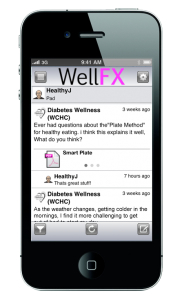 United Health Centers of San Joaquin (UHC), a safety-net provider in California's San Joaquin Valley, is betting on social engagement for controlling and preventing chronic diseases, even among a low-income patient population.
United Health Centers of San Joaquin (UHC), a safety-net provider in California's San Joaquin Valley, is betting on social engagement for controlling and preventing chronic diseases, even among a low-income patient population.
The organization, which serves 46,000 patients a year, most of them uninsured or on Medicaid, at eight locations throughout the sprawling region, last week announced that it had contracted with WellFX, developer of an online and mobile social platform for healthcare providers and patients to manage chronic diseases.
"Our goal with WellFX is to get patients engaged in their own wellness and care," UHC CEO Colleen Curtis tells MobiHealthNews. "How do we reach the most patients with the limited amount of money that we have?"
The patient population is poor, with about 80 percent at or below 200 percent of the federal poverty line, according to Curtis, but that is not a deterrent. "Social media is still something that's within their reach," she says.
Still, the learning curve may be steep, for patients and providers alike.
In addition to the WellFX social platform, employees and patients of UHC will have access to Resolution, the Petaluma, Calif-based vendor's online exercise and dietary program. At the moment, however, UHC is trying to figure out how to deploy these technologies.
What is known is that the program will start with about 5,000 patients. UHC plans to begin implementation in April after clinicians decide which patients to target and what messages to deliver online. Much of the material will have to be translated into Spanish, Curtis notes.
Beyond that, a lot is uncertain. Management will be turning to physicians to help identify participants, for example, patients with diabetes. "The idea is that we reach the patients through the providers," Curtis explains.
"We are excited to develop this portal with health information consistent with what physicians say," says David Phillips, UHC's director of community development and public relations. It will be up to clinicians to decide whether to emphasize diabetes, dental care, nutrition or some other area.
The organization already has a means of sending mass e-mails to targeted patient populations and others who sign up to receive messages through the clinics' interactive Web page. "Our providers can develop their own 'group mail,' so to speak," Phillips says. It may be that initial users of the social platform will come from these rolls, he suggests.
"We've got a great variety of staff who will be involved," Curtis adds. In addition to physicians and nurses, the clinics have perinatal workers, caseworkers health educators, nutritionists and a variety of other health and wellness professionals. "We'll learn as we go as well."
Some of the caseworkers will be reaching out to patients, primarily by phone, to help patients learn how to use the WellFX platform, Curtis says.
In the future, it is possible that UHC will lean on the WellFX system to help it meet the "meaningful use" Stage 2 directive that 50 percent of patients be given access to their own electronic health records through a portal and that 5 percent actually take advantage of this capability. The organization still has not reached Stage 1, but Curtis believes health information exchange, a key adjunct to the EHR, will help drive the kind of patient engagement the clinics want from the social platform.
"In order to get patient engagement, there will be an HIE," Curtis says.
UHC is working with seven other similar safety-net providers as part of the Central Valley Health & Nutrition Collaborative, to roll out EHRs and pursue federal incentive money for meaningful use. About 250 physicians recently started using the EHR, according to Curtis, though none has attested for Stage 1 yet.
She says the WellFX platform initially will not be able to access data from patient records. "But it is still early on," Curtis says.














